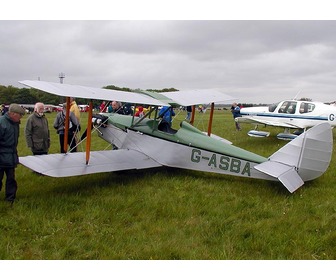Currie Wot

The Currie Wot (pronounced as what) was a 1930s British single-seat aerobatic biplane aircraft. Plans were sold for home building of the aircraft.
G-ASBA of this Currie Wot is the horizontal stabilizer. The
drooped surface hinged to it, nearly touching the grass, is the
elevator.1
design of a Currie Wot home built biplane as a starting point, he
modified it to resemble the Hawker Fury, albeit on a slightly
smaller scale.2
BOTLEY:Dr Urmston built Currie Wot G-ARZW & Fury Replica G-ASCM in a workshop in Winchester Street. . BOTLEY Park Hotel:Helipad at 50º55.85N/001º16.71W .3
Currie Wot 44" for 2.5-3.5cc up to .40 4 stroke by Bob Wright
Curtis Hawk 42” elec 540 motor using belt drive
D.4
Currie Wot home built biplane as a starting point, he modified it to
resemble the Hawker Fury, albeit on a slightly smaller scale.5
Currie Wot), i wish to set up aileron differential to give me more up
than down.6
diminutive Currie Wot byplane after his retirement in 1967 and
sampling other types whenever the opportunity arose.7
Made by Homebuilt.
Here are the four Currie Wot aircraft that I came across on the FAA
Registry.8
I think the Currie Wot-based SE5s were 7/8ths scale or somesuch and
may have been built by Slingsby, I don't have my references to hand.9
The Currie Wot was designed by Mr J.R. Currie, a lecturer at the
Chelsea College of Aeronautical Engineering, in 1937.10
These were based on the Currie Wot airframe and were referred to as
Minis due to their not being full size reproductions.11
This nicely finished Currie Wot was entered in the Peanut class by
Phil Morgan.12
Taking the Currie Wot as an example, his Fury replica was
all wood, with fabric covered wooden wings, and ailerons on the top
wing only.13
Height Main
205.74
Height Alt
2.06 m
Designer
J.R.Currie
Length Alt
5.58 m
Max Takeoff Weight Main
900.0
Jet Or Prop
prop
Range Main
240 miles
Max Speed Alt
83
Max Speed Main
95 mph
Max Takeoff Weight Alt
408.0
Type Of Prop
two-cylinder
Crew
1
Span Main
673.1
Area Main
140.0
Span Alt
6.73 m
Plane Or Copter?
Power Alt
30.0
Engine(prop)
Aeronca E-113
Manufacturer
First Flight
1937
Climb Rate Main
600.0
Power Main
40 hp
Number Of Props
1
Climb Rate Alt
3.0 m-s
Length Main
18
Area Alt
13.0 m²
Range Alt
209
Empty Weight Main
550.0
Empty Weight Alt
250.0
Category
